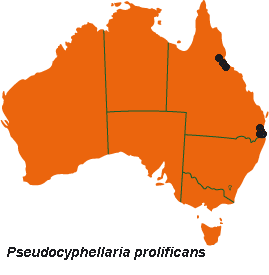



Australian Biological Resources Study
| Checklist of the Lichens of Australia and its Island Territories | ||
| Introduction | A–D | E–O | P–R | S–Z | Oceanic Islands | References | ||
| Pseudocyphellaria prolificans (Nyl.) Vain. | ||
| Philipp. J. Sci., Sect. C, Bot. 8: 117 (1913); Sticta prolificans Nyl., Ann. Sci. Nat. Bot., sér. 4, 15: 42 (1861). T: "ad cortices sylvarum in Kanala", New Caledonia, E.Vieillard 1795; holo: PC. | ||
| Thallus rosette-forming to irregularly spreading, often densely entangled, loosely to closely attached centrally, 5–12 (–15) cm wide. Lobes rather narrow, linear-laciniate (1–6 cm long and 2–5 mm wide) to ±rounded (8–15.5 mm wide), subdichotomously branching near apices, complex-imbricate centrally; apices truncate, rounded or divergent; lobe margins entire towards apices, becoming densely phyllidiate centrally, thickened above and below, often with prominent pseudocyphellae below. Upper surface pale greenish grey to fawnish when dry, lettuce-green to olive-green when wet, undulate, irregularly to strongly dimpled, punctate-impressed; without isidia, maculae, pseudocyphellae or soredia. Phyllidia common, mainly marginal but also laminal, terete, soon becoming flattened, dorsiventral, simple to branched, single to densely clustered and proliferating, to 5 (–10) mm tall, 0.1–0.5 mm wide. Medulla white. Photobiont green. Lower surface tomentose from margins to centre or only in older parts; tomentum whitish to pale yellow-brown or red-brown. Pseudocyphellae common, conspicuous, white, projecting from tomentum. Apothecia rare, marginal or submarginal, subpedicellate, 2–5.5 mm diam.; disc dark red-brown to chestnut-brown; exciple pale, corrugate-scabrid; epithecium pale yellow-brown; hymenium colourless. Ascospores fusiform-ellipsoidal, simple to 1-septate, 28–33.5 × 6.5–8 µm, yellow-brown. CHEMISTRY: Tenuiorin, methyl gyrophorate, gyrophoric acid, 4-O-methylgyrophoric acid (congyrophoric acid), 7β-acetoxyhopane-22-ol, hopane-7β,22-diol (trace) and hopane-15α,22-diol. |  |
|
| Occurs in north-eastern Qld, on trunks and branches of trees and on shrubs and rocks in rainforest. Also in Lord Howe Is. and in the Palaeotropics from Sri Lanka to Fiji. | ||
| Galloway et al. (2001) | ||
| Checklist Index |
| Introduction | A–D | E–O | P–R | S–Z | Oceanic Islands | References |
This work is copyright. Apart from any use as permitted under the Copyright Act 1968, no part may be reproduced by any process without prior written permission from Australian Biological Resources Study. Requests and inquiries concerning reproduction and rights should be addressed in the first instance to Dr P. McCarthy. These pages may not be displayed on, or downloaded to, any other server without the express permission of ABRS.